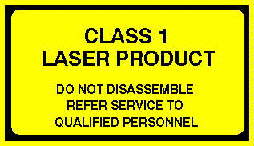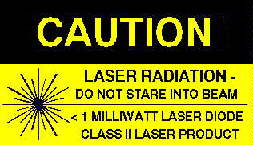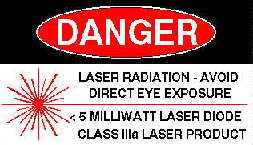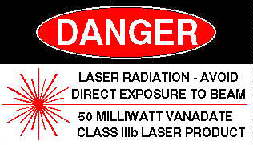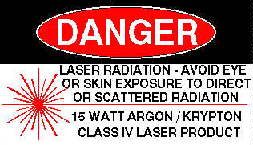|
|
 |
Laser Light Shows
|
|
 |
Laser Show Systems
|
|
|
 |
Laser Displays
|
|
 |
Laser Effects
|
|
 |
Laser Safety
|
|
|
 |
 |
|
Lasers and Safety
|
 |
 |
|
Precision Projection Systems is fully committed to the safe use of laser systems in any public display, and to safe practices in all other laser applications. If you have concerns about the safety of any laser display or laser display system, or that of any other laser product or equipment, please contact us. We will gladly assist you with any question related to laser safety at no charge.
|
 |
 |
|
|
|
For productions requiring laser safety assistance, Precision Projection Systems offers complete consulting services to the highest professional standards. We offer services for preparation of laser show variances, laser product and laser light show reports, annual reports, and quality control documents and procedures . We can also assist with calculations required for certification of indoor and outdoor displays, and with the submission of documents to local, state, and federal regulatory agencies. We can also assist customers with an independent evaluation of their laser safety practices, with the development of corrective action plans required to reestablish safe procedures, and with the correction of any deficiencies which may be found during our own review, or during a formal inspection by regulatory officials.
|
|
 |
 |
 |
 |
 |
 |
 |
 |
 |
 |
 |
 |
 |
 |
|
Potential For Injuries
|
|
|
|
Contrary to the way they are often depicted in the movies, lasers are not "death rays".
|
|
|
Like any other form of energy, laser emissions are relatively harmless at low power levels, and become progressively more hazardous as the emitted power level increases. Only the highest powered industrial laser systems producing hundreds or thousands of watts emit enough energy to cause lethal injuries. Lasers do not generally emit any "ionizing radiation" such as X-rays, gamma rays, or any other form of hazardous emissions associated with radioactivity. Lasers are extremely powerful light sources however, and the human eye is remarkably effective in gathering and sensing light. Accordingly, the greatest danger presented by all but the most powerful laser systems is an eye injury.
|
|
|
|
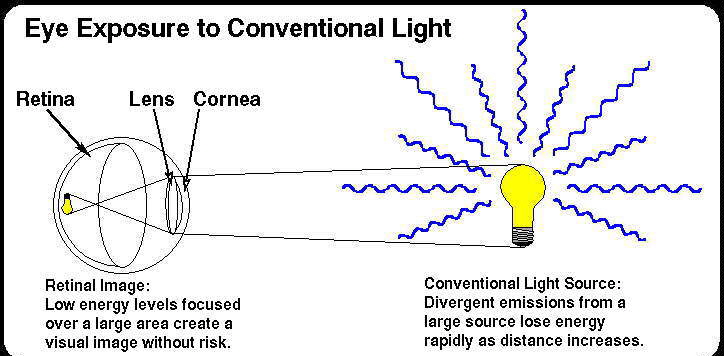 |
|
|
|
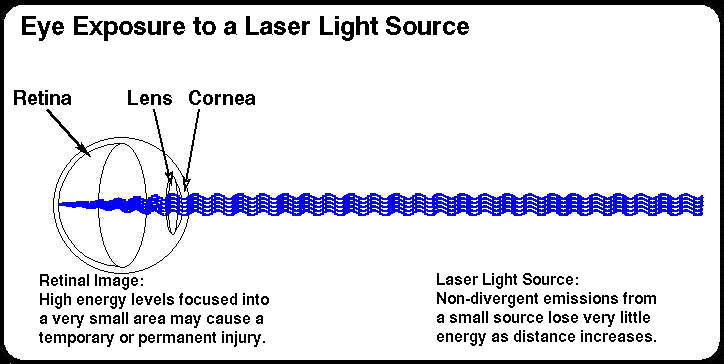 |
|
|
|
Basic Safety Regulations
|
|
 |
 |
|
To insure public safety, the sale of laser products in the U.S. and in many other countries is strictly regulated. All laser products sold in the US are classified into one of five categories according to the amount of accessible emissions they produce. Safety features are required for all laser products, with the number of safety features increasing as the output power and potential hazard of the laser system rises. All manufacturers or importers of laser equipment must file reports describing their products, and certify that they meet the requirements for products of their class.
|
 |
 |
|
Safety requirements for the various classes include user information packages, warning labels, protective housings, keyswitches, emission indicators, laser beam attenuators, interlocks, and other performance features. These safety features must be installed as required for each class of laser product, and the products must be tested to insure that the mandated features are installed and functional before the products can be sold.
|
 |
 |
|
Using Lasers
|
 |
 |
|
The safety features which must be incorporated into any laser products in the U.S. are intended to inform the user of the nature of the hazard the laser presents, and to reduce the possibility of accidental injury from exposure to laser light. With these safety features in place, there are presently no restrictions on who may purchase a laser system at any power level. However, the cost of a laser system rises quite rapidly as the output power increases, and the highest power systems are very expensive. Also, occupational safety agencies such as OSHA have regulations which govern the safe use of lasers in the workplace, and special rules apply to medical laser systems, entertainment displays, and lasers for scientific research, or for military applications.
|
 |
 |
|
Laser Classes
|
|
|
 |
 |
|
Class I Class I laser products produce no accessible laser emissions. For example, a CD player or DVD player/recorder contains an internal laser to read or write data, but does not actually emit any laser light. Products of this type are Class I laser systems. Class I lasers products present no hazard at all unless they are disassembled to gain access to the internal components.
|
|
|
|
 |
 |
|
Class II Class II laser products can emit up to 1 milliwatt (1/1000th watt) of accessible laser emissions. Low powered laser pointers, data and telecommunications gear, and some scientific systems use lasers of this output classification. Class II laser products are not capable of causing permanent eye injuries, but can still be quite hazardous due to glare and temporary flash blindness.
|
|
|
|
 |
 |
|
Class IIIa Class IIIa laser products can emit up to 5 milliwatts (5/1000th watt) of accessible laser emissions. The most common laser pointers, and all inexpensive laser display systems fall into this output classification. Class IIIa lasers pose an eye hazard with prolonged exposure, and should not be directed towards the eyes or face, and should never directed into or out of a moving vehicle.
|
|
|
|
 |
 |
|
Class IIIb Class IIIb laser products can emit up to 500 milliwatts (½ watt) of accessible laser emissions. Some scientific and medical systems, and low powered laser display systems may be classified into this category. Class IIIb lasers are capable of causing a permanent eye injury with brief exposure, can cause minor skin burns, and can ignite many materials with sustained or focused exposure.
|
|
|
|
 |
 |
|
Class IV Class IV laser products emit any amount of power greater than 500 milliwatts (1/2 watt). Industrial laser systems, research, scientific, and medical lasers, and the largest laser display systems are Class IV laser products. Class IV lasers can cause permanent eye injury before you can react, can cause serious skin burns, and can quickly ignite flammable materials at a considerable distance.
|
|
 |
 |
|
Laser Display Regulations
|
|
|
 |
 |
|
Within the U.S., laser products for demonstration or public display purposes are limited to Class IIIa power levels, or 5 milliwatts. Even systems within this 5 mW limitation should not be used carelessly. Higher powered systems and displays are permitted to operate under the conditions of a special permit, called a variance. Without this document, displays using lasers more powerful than a laser pointer are prohibited. To obtain an approved variance, a laser show producer agrees to certify each display to meet a set of safety standards which insure that there is no risk of injury to the public, or to performers on stage from the higher laser power levels allowed.
|
|
 |
 |
|
Laser Light Show Safety
|
 |
 |
|
In the US, variances are issued by the Food and Drug Administration, through the offices of the Center for Devices and Radiological Health, or CDRH. Under the terms and conditions of a variance, a laser show or laser effect is considered to be another form of laser product, which is subject to the same regulations as other laser devices and products. The standard conditions of a laser light show variance require a laser show producer to have a copy of their variance on hand at each production. If a laser effects contractor is unable or unwilling to provide a copy of their variance, they may not have the legal basis to perform the effects required.
Variances require that all laser projection equipment meet the same requirements as any other laser product of that class, and must be tested to insure compliance. In addition to the equipment meeting the performance standards, the laser effects themselves must also be tested by the producers to certify that they meet the applicable safety standard called for in the variance. The applicable standard in this case is a Class I laser power level in the audience area. Class I laser light levels are extremely low energy, and insure that the audience is not at any risk of injury from the effects displayed.
Maintaining a Class I display generally means adequate separation between the audience and the path of any high powered laser emission. Regulations require a minimum separation of 3 meters (about 10 feet) vertically, and 2.5 meters horizontally (about 8 feet), between high powered laser effects and any area where the audience is permitted to sit or stand. Effects passing closer to the audience are permissable only when alternative means of protection, such as hard barriers or guest restraints are in place and active.
Laser effects which terminate on front or rear projection screens are usually considered harmless, because the laser light scattered off the screen is dispersed and rapidly loses energy. A laser beam reflected off of a mirror remains hazardous, and these effects must maintain adequate separation, and must terminate in a safe area on suitable materials.
Because of the Class I exposure limitation, laser effects which fall directly onto an audience area, or onto performers on stage are generally prohibited. Even the relatively harmless emissions from a 5 milliwatt laser pointer will quickly exceed the Class I threshold when pointed directly into the eye.
While it is possible to successfully stage these effects, the safeguard technology required to insure safety in the event of an equipment failure is not a simple matter, and must also be certified to perform as required. A laser effects contractor who stages an "audience exposure" effect without testing and meaurements is almost certainly exceeding the legal Class I exposure limit allowed in the variance. Directing even a measured, Class I effect into the audience without a properly designed and certified safeguard is operating outside the conditions of the variance, and puts the audience, the contractor, and the production at risk in the event of a failure and a guest injury.
|
 |
 |
|
Outdoor Laser Displays
|
 |
 |
|
When a laser display takes place outdoors, and involves the projection of laser light into open airspace, The Federal Aviation Administration, or FAA, in addition to the CDRH, has jurisdiction. Outdoor laser displays typically take place at night in urban areas, often within a few miles of an airport. The FAA has determined that even a minimal amount of laser power directed at an aircraft on approach, during a landing, or on takeoff may have the potential to distract the flight crew, or otherwise affect their ability to safely control the aircraft. To minimize any risk to private or commercial air traffic, the FAA has established regulations governing the safe use of lasers in outdoor displays. All outdoor productions which use unterminated laser effects are required to notify, and obtain the permission of the FAA for the aerial effects to be displayed.
|
 |
 |
|
Summary
|
 |
 |
|
The use of lasers at power levels of 5 milliwatts or less for demonstration and display purposes is not restricted, but simple precautions are advisable. High powered laser displays and laser light show effects are potentially hazardous, and the use of higher powered effects in the U.S.is strictly regulated to insure public safety. When properly staged in compliance with applicable regulations, high powered effects do not pose a hazard to the audience, to talent on stage, or to the production staff. Obtaining the services of a qualified and competent laser effects specialist or contractor is an essential element whenever high powered laser effects are to be employed. .
|
|




